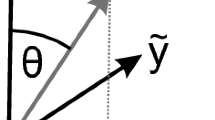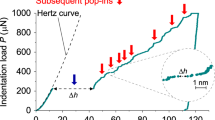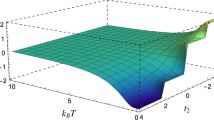Abstract
Poisson's ratio is, for specified directions, the ratio of a lateral contraction to the longitudinal extension during the stretching of a material. Although a negative Poisson's ratio (that is, a lateral extension in response to stretching) is not forbidden by thermodynamics, this property is generally believed to be rare in crystalline solids1. In contrast to this belief, 69% of the cubic elemental metals have a negative Poisson's ratio when stretched along the [110] direction. For these metals, we find that correlations exist between the work function and the extremal values of Poisson's ratio for this stretch direction, which we explain using a simple electron-gas model. Moreover, these negative Poisson's ratios permit the existence, in the orthogonal lateral direction, of positive Poisson's ratios up to the stability limit of 2 for cubic crystals. Such metals having negative Poisson's ratios may find application as electrodes that amplify the response of piezoelectric sensors.
This is a preview of subscription content, access via your institution
Access options
Subscribe to this journal
Receive 51 print issues and online access
$199.00 per year
only $3.90 per issue
Buy this article
- Purchase on Springer Link
- Instant access to full article PDF
Prices may be subject to local taxes which are calculated during checkout



Similar content being viewed by others
References
Keskar, N. R. & Chelikowsky, J. R. Negative Poisson ratios in crystalline SiO2from first-principles calculations. Nature 358, 222–224 (1992).
Gibson, L. J., Ashby, M. F., Schajer, G. S. & Robertson, C. I. The mechanics of two-dimensional cellular materials. Proc. R. Soc. Lond. A 382, 25–42 (1982).
Lakes, R. S. Foam structures with a negative Poisson's ratio. Science 235, 1038–1040 (1987).
Evans, K. E., Nkansah, M. A., Hutchinson, I. J. & Rogers, S. C. Molecular network design. Nature 353, 124 (1991).
Rothenburg, L., Berlin, A. A. & Bathurst, R. J. Microstructure of isotropic materials with negative Poisson's ratio. Nature 354, 470–472 (1991).
Yeganeh-Haeri, A., Weidner, D. J. & Parise, J. B. Elasticity of α-cristobalite — a silicon dioxide with negative Poisson's ratio. Science 257, 650–652 (1992).
Wei, G. & Edwards, S. F. Polymer networks with negative Poisson's ratios. Comput. Poly. Sci. 2, 44–54 (1992).
Baughman, R. H. & Galvão, D. S. Crystalline networks with unusual predicted mechanical and thermal properties. Nature 365, 735–737 (1993).
Smith, W. A. in Proc. 1991 Ultrasonics Symp.(ed. McAvoy, B. R.) 661–666 (IEEE, Piscataway, NJ, (1992)).
Wojciechowski, K. W. Two-dimensional isotropic solid with a negative Poisson's ratio. Phys. Lett. A 137, 60–64 (1989).
Lakes, R. S. No contractile obligations. Nature 358, 713–714 (1992).
Miki, M. & Morotsu, Y. The peculiar behavior of the Poisson's ratio of laminated composites. JSME Int. J. 32, 67–72 (1989).
Lakes, R. S. Deformation mechanisms of negative Poisson's ratio materials: structural aspects. J. Mater. Sci. 26, 2287–2292 (1989).
Milton, G. W. Composite materials with Poisson's ratios close to −1. J. Mech. Phys. Solids 40, 1105–1137 (1992).
Turley, J. & Sines, J. The anisotropy of Young's modulus, shear modulus and Poisson's ratio in cubic materials. J. Phys. D 4, 264–271 (1971).
Milstein, F. & Huang, K. Existence of a negative Poisson ratio in fcc crystals. Phys. Rev. 19, 2030–2033 (1979).
Li, Y. Anisotropic behavior of Poisson's ratio, Young's modulus, and shear modulus in hexagonal materials. Phys. Status Solidi A 38, 171–175 (1976).
Every, A. G. & McCurdy, A. K. in Landolt-Börnstein(ed. Nelson, D. F.) 11–133 (New Ser. III/29a, Springer, Berlin, (1992)).
Gunton, D. J. & Saunders, G. A. The Young's modulus and Poisson's ratio of arsenic, antimony, and bismuth. J. Mater. Sci. 7, 1061–1068 (1972).
Fioretto, D. et al. Brillouin-scattering determination of the elastic constants of epitaxial fcc C60film. Phys. Rev. B 52, R8707–R8710 (1995).
Jain, M. & Verma, M. P. Poisson's ratios in cubic crystals corresponding to (110) loading. Ind. J. Pure Appl. Phys. 28, 178–182 (1990).
Grigoriev, I. S. & Meilikhov, E. Z. (eds) Handbook of Physical PropertiesCh. 25, 697–698 (CRC Press, New York, (1997)).
Miedema, A. R., de Châtel, P. F. & de Boer, F. R. Cohesion in alloys — fundamentals of a semi-empirical model. Physica B 100, 1–28 (1980).
Thomas, J. M. Failure of the Cauchy relation in cubic metals. Scripta Metall. 5, 787–790 (1971).
Gilman, J. J. Bulk stiffnesses of metals. Mater. Sci. Eng. 7, 357–361 (1971).
Ashcroft, N. A. & Mermin, N. D. Solid State PhysicsCh. 2, 30–55 (Holt, Reinehardt & Winsten, New York, (1976)).
Cousins, C. S. G. & Martin, J. W. Extended Cauchy discrepancies — measures of non-central, non-isotropic interactions in crystals. J. Phys. F 8, 2279–2291 (1978).
Cousins, C. S. G. Evidence for short range, three-body interactions in copper. J. Phys. F 3, 1915–1920 (1973).
Nakamura, M. Fundamental properties of intermetallic compounds. Mater. Res. Soc. Bull. XX(8), 33–39 (1995).
Acknowledgements
We thank R. S. Lakes, J. J. Gilman, L. W. Shacklette, R. C. Morris, and S. O. Dantas for important comments.
Author information
Authors and Affiliations
Corresponding author
Supplementary Information
Rights and permissions
About this article
Cite this article
Baughman, R., Shacklette, J., Zakhidov, A. et al. Negative Poisson's ratios as a common feature of cubic metals. Nature 392, 362–365 (1998). https://doi.org/10.1038/32842
Received:
Accepted:
Issue Date:
DOI: https://doi.org/10.1038/32842
This article is cited by
-
Non-affinity: The emergence of networks from amorphous planar graphs
Science China Physics, Mechanics & Astronomy (2023)
-
Elastic properties of polycrystalline silicon: experimental findings, effective estimates, and their relations
Continuum Mechanics and Thermodynamics (2023)
-
A three step recipe for designing auxetic materials on demand
Communications Physics (2022)
-
Scrutinized the inherent spin half-metallicity and thermoelectric response of f-electron-based RbMO3 (M = Np, Pu) perovskites: a computational assessment
Scientific Reports (2022)
-
Models and auxetic characteristics of a simple cubic lattice of spherical particles
Continuum Mechanics and Thermodynamics (2022)
Comments
By submitting a comment you agree to abide by our Terms and Community Guidelines. If you find something abusive or that does not comply with our terms or guidelines please flag it as inappropriate.



